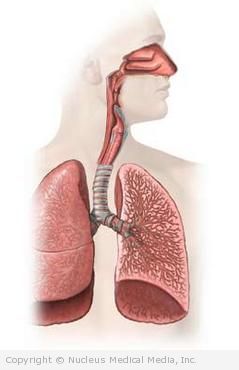Atelectasis
(Collapsed Lung)
Atelectasis – Definition
Atelectasis is a condition where a portion of the lung has collapsed or is not able to completely expand. Normally, oxygen enters the body through the lungs. Carbon dioxide is released through the lungs. The lungs expand and contract to create the exchange of these gases. Atelectasis is not a disease, but a condition or sign that results from disease or abnormalities in the body.
Atelectasis – Causes
Causes include:
- Fluid in or around the lungs
- Infection
- Blockage of airways in the lungs due to tumors, mucus, or a foreign object
- Compression, resulting from emphysema, an enlarged heart, or a tumor
- Restricted chest movement, due to bone or muscle problems, or recent abdominal surgery
- Scarring, as a result of radiation therapy, frequent infections, or disease
- Injuries
- Pneumothorax (leakage of air into the space surrounding the lungs)
- Lung immaturity in premature babies
Atelectasis – Risk Factors
Factors that increase your chance for atelectasis include:
- Advanced age
- Premature birth
- Lung diseases, such as:
- Asthma
- Lung cancer
- Emphysema
- Pulmonary edema
- Pneumothorax
- Pleural effusion
- Smoking
- Congestive heart failure
- Obesity
- Scoliosis
- Conditions that limit physical activity such as stroke, spinal cord injury, heart problems, trauma, or severe illness of any kind
- Anesthesia, especially in patients who are obese or smoke
- Breathing supplemental 100% oxygen
- Breathing in a foreign body, such as a peanut or a marble
- Injury to the chest wall
Atelectasis – Symptoms
A collapsed lung may or may not cause symptoms. Small areas of collapse are less likely than larger areas to cause symptoms. Major atelectasis decreases the amount of oxygen available throughout the body.
Symptoms that may occur if a large area has collapsed include:
- Rapid breathing
- Shortness of breath
- Taking shallow breaths
- Coughing
- Decreased chest movement during breathing
- Wheezing
- Fever
- Rapid heart rate
- Chest pain
- Blueness of the lips or nails
Atelectasis – Diagnosis
The doctor will ask about your symptoms and medical history. A physical exam will be done. This may include listening to your lungs for changes in the normal sounds.
Tests may include:
- Chest x-ray — a test that uses radiation to view the lungs and locate a collapsed area
- Bronchoscopy — use of a thin, lighted tube, which is inserted down the throat, to examine the lungs and air passages
- Additional tests to assess the status of the heart, blood vessels, and airways
Atelectasis – Treatment
Treatment focuses on treating the underlying cause and maintaining adequate air supply. The collapsed lung usually expands once the underlying cause has been corrected. Atelectasis often resolves on its own without treatment.
Treatments include:
Physical Therapy
The therapist uses different techniques to help clear mucus from the lung. You will be positioned so that gravity helps secretions flow out of the body. When resting in bed, lie on the unaffected side to promote drainage from the lung that has collapsed.
Respiratory Therapy
This may include any or all of the following:
- Breathing masks or treatments to help keep your airways open
- Incentive spirometry to help you learn to take deeper breaths
- Suction to help remove secretions
- A breathing machine, called a ventilator, if you are unable to breathe adequately on your own
Medication
Medications may include:
- Drugs to open the airways
- Drugs to treat the disease that caused the collapse
- Antibiotics to treat an infection
- Cardiac drugs to control heart disease
- Inhalers and other drugs to manage asthma or emphysema
- Oxygen, if you are having trouble breathing
Bronchoscopy
Bronchoscopy may be used to remove a foreign body or mucus that is blocking the airway.
Atelectasis – Prevention
Measures to prevent atelectasis are related to the various causes. They include:
- If you smoke, stop.
- If you are obese, lose weight.
- If you have a chronic lung or heart condition, follow your doctor’s advice for managing the disease and limiting complications.
- If you are pregnant, get prenatal care and follow your doctor’s instructions.
- Try not to inhale something solid. For example, chew your food well before swallowing.
- After surgery, follow instructions for deep breathing, coughing, and turning. Ask for pain medication if discomfort is limiting movement or coughing.

